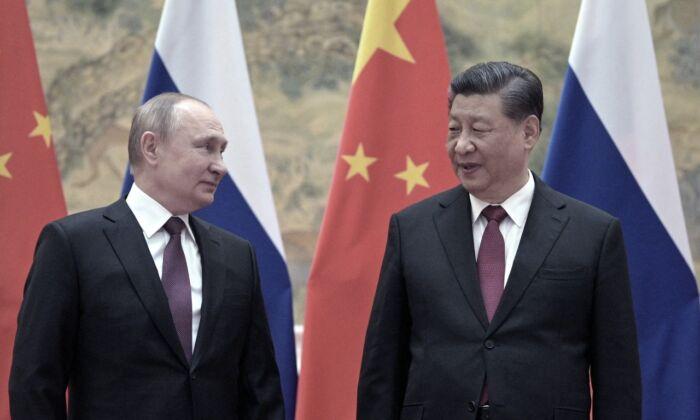Commentary
It’s long been reported by The Epoch Times that China—and more recently due to the ongoing war, Russia—has been keen to see the U.S. dollar knocked from its perch as the biggest global reserve currency.
Russia and China have now begun working on that, which isn’t a surprise. But what is a surprise is the announcement that several emerging market nations are working on it together with Russia and China. Russia Today (RT)—a Russian state-owned English-language media—reported in June Russian President Vladimir Putin announced that BRIC nations including Russia, China, India, Brazil, and South Africa are working on setting up a new global reserve currency.
“According to the Russian president, the member states are also developing reliable alternative mechanisms for international payments,” RT said.
This news was somewhat lost in the shuffle last month as the U.S. economy was battered by rising inflation, a potential economic downturn, stock market volatility, crypto market turmoil, technology industry layoffs, and concerns around President Joe Biden’s health and low popularity.
Of course, Western nations’ sanctions against Russia and freezing of its foreign exchange reserves have been destructive to Russia’s economy. And the removal of Russian banks from the international SWIFT system means that the country is largely cut off from U.S. dollar transfers. As of Q1 2022, around 59 percent of all allocated global FX reserves were denominated in the dollar, with the euro at second place with 20 percent, according to IMF data.
The fact that other BRIC nations such as India and South Africa have joined Russia and China in building a new global currency to combat the dollar’s hegemony is surprising. A coordinated global effort to displace the U.S. dollar should not be dismissed.
The signs have been there all along. Once one of the biggest holders of U.S. treasury bonds, Russia has been selling U.S. treasuries for the last five years. At the beginning of 2018, Russia held almost $100 billion worth of U.S. treasuries. That figure had steadily fallen to about $10 billion by early 2020, and by April 2022, it had fallen to only $2 billion.
During this time, Russia has also been building up its gold reserves. Russia’s gold buying spree began when it was sanctioned in 2014 for its annexation of Crimea—with perhaps its plan to dethrone the U.S. dollar as the global reserve currency also going back that far. Russia’s holding of gold sat at 2,302 metric tons as of the first quarter 2022, up from around 1,000 in 2014, according to data from World Gold Council.
Immediately after sanctions against Russia kicked in earlier this year, one of Moscow’s first responses was to force European countries dependent on Russian gas exports to pay in rubles or gold. Countries complied and bought up rubles and sold off euros. Interestingly, despite Russia defaulting on its debt, its ruble currency has been strengthening this year.
Is a new commodity-backed global reserve currency backed by China and Russia becoming a reality? I wrote in this column in March that it was a possibility, supported by analysis from Credit Suisse rates strategist Zoltan Pozsar and Jeffries macro strategist Sean Darby. Russia, after all, is a major supplier of commodities including oil, gas, gold, and diamond.
I suggested back then that third-party countries could buy Russian oil at a discount from Russia or by way of China as opposed to paying a premium for non-Russian-sourced oil. That could be the beginning of a new global order and everything China and Russia had wished for. Tangentially, it’s also a convenient way to broaden usage of the digital renminbi.
RT claimed in July that is exactly what had happened. Trade between Russia and other BRIC nations during the first three months of 2022 increased 38 percent to $45 billion. Meanwhile, trade between Russia and China continues to swell, with Russia edging Saudi Arabia to become China’s No. 1 oil supplier, after Russian oil has been sanctioned by most of the West. Other nations have also begun accepting currencies other than “petrodollars” for exports, with Saudi Arabia and Iran accepting yuan for their oil.
The real question is what form this currency will take. For this currency to have real value it needs to be backed by more than the credit of the governments of BRIC nations. It must be backed by commodity reserves.
Will other countries want to transact in this new currency? At first, not likely. But the landscape could change over time; almost all of the major currencies today are fiat money based on nothing beyond the faith and credit of the issuing country. As political and social foundations are uprooted and challenged around the world and if inflation continues to exacerbate, a new reserve currency backed by gold and oil—in other words, real assets—could be formidable.
Before we declare the dollar’s dominance over, it has several indomitable traits. First is that as a currency, it is strengthening as the Federal Reserve have begun to raise interest rates. The U.S. financial markets remain the world’s largest, safest, most liquid, and most trustworthy market to invest in. In addition, the stability and reputation of the U.S. government and legal system makes holding U.S. government bonds preferable to other reserve assets.
But in the near term, the dollar should remain a strong reserve currency contender. Perhaps it is the euro and other currencies that warrant worry.





